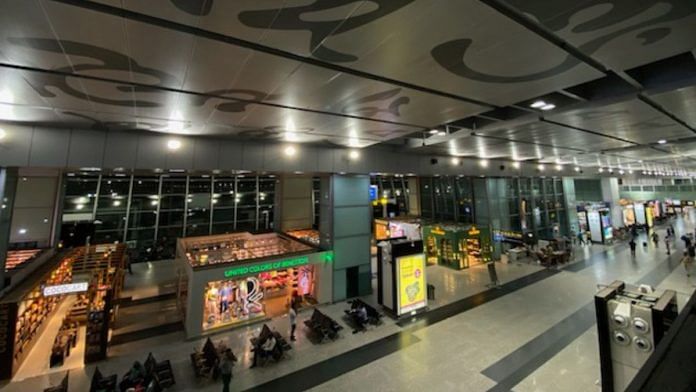There are 139 airports in the country that are run either by the Airports Authority of India (AAI) or under public-private partnership (PPP). Of these only 21 were able to generate profits in the 2022-23 financial year, showed ThePrint’s analysis of data shared by Minister of State for Civil Aviation V. K. Singh in Lok Sabha last month.
According to Waseem Ahmed Khan, senior industry analyst, aerospace and defense, at the business consulting firm Frost & Sullivan, operating an airport is a capital-intensive business that requires significant investment in strategic areas such as the development of new terminal buildings and digital transformation.
The pandemic has affected airport revenues “drastically” since they are directly dependent on aircraft movement and passenger traffic, he told ThePrint Friday when asked about why India’s airports weren’t able to generate profits. And added that with passenger traffic expected to return to 2019 (pre-Covid pandemic) levels only in 2024, airports have definitely taken a hit when it comes to revenue, if not a loss.
According to MoS Singh’s written reply in Lok Sabha on 27 July, of the 125 domestic airports run by AAI — a public sector undertaking under the Ministry of Civil Aviation — only 18 registered profits in the past financial year, while 15 recorded neither profits nor losses. This was, however, an improvement over the previous year (2021-22 financial year), when only 11 airports run by AAI saw profits.
Of the 14 airports run under PPP mode, only three registered profits in 2022-23, the data shared in Lok Sabha showed.
Singh was replying to a question raised by Dravida Munnetra Kazhagam (DMK) MP S.R. Parthiban on the number of airports run by the Union government and those that are privately operated, and their annual profits or losses for the past five years.
In reply to a second question raised by Congress MP Benny Behanan last week on profitability of airports, Singh added that the government has undertaken significant steps to reassess costs and ensure the profitability of airports operated by AAI.
“These include augmentation of non-aeronautical revenue via master concessionaires, optimum utilisation of commercial space, city-side development, revenue share model for select commercial contracts and airport charge enhancements,” the MoS said.
AAI appoints master concessionaires to develop, build, finance, operate and maintain the food and beverages, retail and duty-free outlets at airports.
MoS Singh added that AAI is also optimising operational costs through utility enhancements — such as LED replacements and solar panel installations — while also implementing automation of airport systems and outsourcing of non-core activities, to achieve cost-effective management.
“These measures collectively aim to ensure sustainable profitability and improved services at airports,” he said.
Also read: Why Air India’s jumbo order for 470 jets could mark a turning point for Indian aviation
Making airports profitable
The revenue model of airports can be broadly classified into two types — aeronautical revenue and non-aeronautical revenue.
Aeronautical revenue includes fees that airports directly collect from airlines, such as landing and parking charges and terminal building office charges. In addition, there are fees generated from ground handling services, collected from outsourcing partners like cargo operators, refueling service providers and airport development fees charged indirectly from passengers via airlines.
Non-aeronautical revenue refers to those sources of revenue collected by airports that are not related to aviation, such as rent from duty-free shops and shops located in airport terminals, public and private parking charges collected from cab aggregators, and personal vehicles.
Of the 18 profitable AAI airports, only 11 saw profits of over Rs 10 crore, according to data shared in Lok Sabha. These include Bhubaneswar (Rs 11.81 crore), Calicut (Rs 95.38 crore), Chennai (Rs 169.56 crore), Coimbatore (Rs 12.65 crore), Deogarh (Rs 28.84 crore), Goa (Rs 48.39 crore), Juhu (Rs 13.31 crore), Pune (Rs 74.94 crore), Srinagar (Rs 26.95 crore) and Tiruchirapalli (Rs 31.51 crore). The highest profit of Rs 482.30 crore was reported by Kolkata airport.
Of the 14 airports run under PPP mode, only three — Bengaluru (Rs 528.31 crore), Cochin (Rs 267.17 crore), and Hyderabad (Rs 32.99 crore) — registered profits in 2022-23.
The others saw losses — Kannur (Rs 131.98 crore), Delhi (Rs 284.86 crore), Mumbai (Rs 1.04 crore), Ahmedabad (Rs 408.51 crore), Lucknow (Rs 160.66 crore), Mangaluru (Rs 125.98 crore), Jaipur (Rs 128.52 crore), Guwahati (Rs 60.97 crore), Thiruvananthapuram (Rs 110.15 crore), Durgapur (Rs 9.10 crore) and Mopa (Rs 148.34 crore).
Asked about steps needed to make airports profitable entities, Nripendra Singh, global research director, aerospace and defense, Frost & Sullivan, said that major airports should attract more foreign airlines from countries with whom India has signed bilateral agreements.
“They (airports) can offer them competitive landing fees and other incentives to encourage them to come,” he said, adding that regional and smaller airports should also attract domestic airlines by creating a strong business case highlighting the benefits of the government’s UDAN-RCS scheme.
He further added: “Investing in digital transformation is also an essential step. Airports around the world are automating passenger processing, and Indian airports must do the same. Technologies like self-bag drop and self-service kiosks can help enhance passenger experience and productivity.”
According to Khan, “in the past few years, airports have been unable to generate profits from both aero and non-aero revenue streams [owing to the pandemic]”.
He added, however, that there may be some hope on the horizon for airports.
“In H1 [first half] 2023, airlines like Air India and IndiGo airlines have placed mammoth aircraft orders, which is expected to attract more passenger traffic. With this, airports may be able to turn their fortunes around and become profitable once again,” Khan said.
(Edited by Poulomi Banerjee)
Also read: Boost for aviation maintenance providers as sector grows. Revenue to triple by FY28, says CRISIL



